1996 NISSAN FRONTIER towing
[x] Cancel search: towingPage 181 of 198
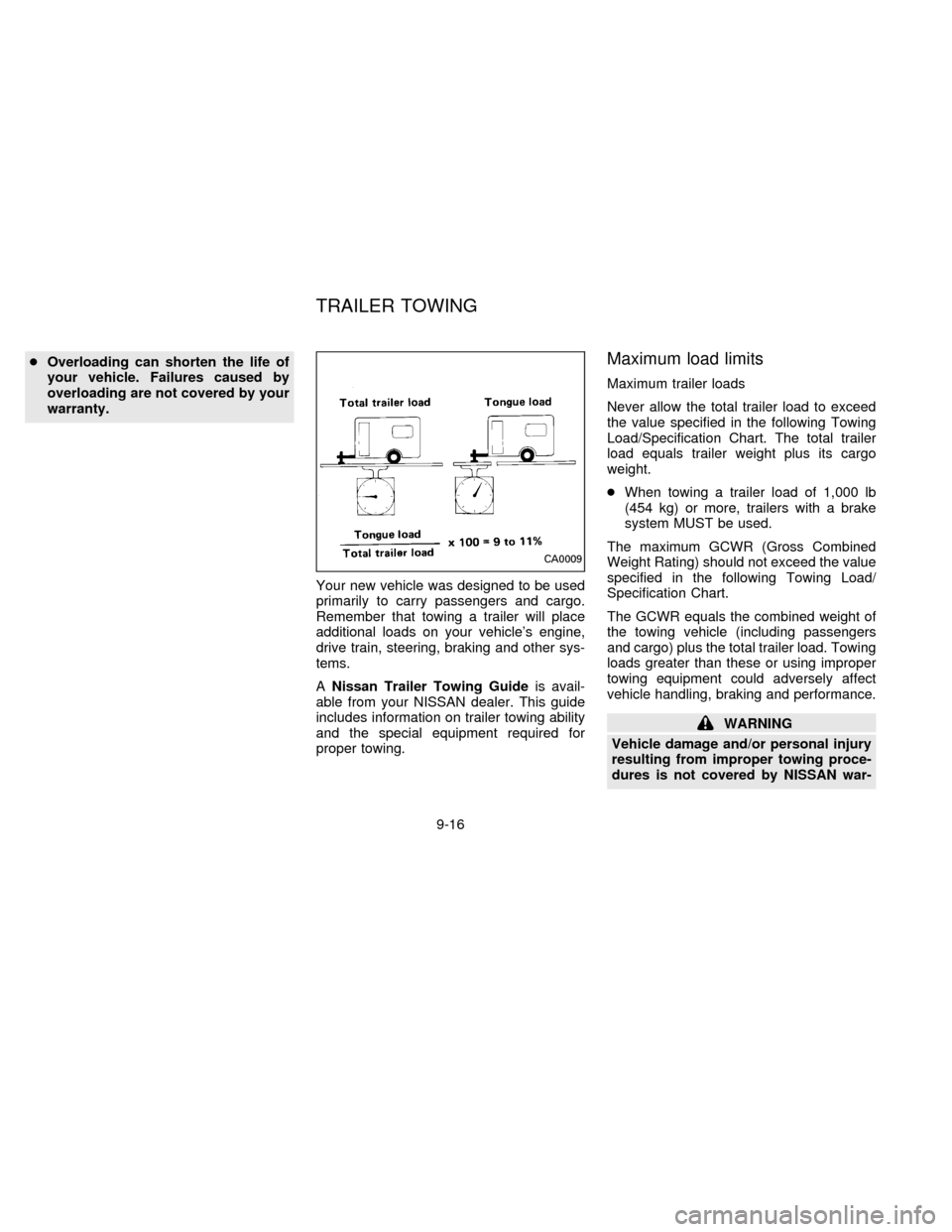
cOverloading can shorten the life of
your vehicle. Failures caused by
overloading are not covered by your
warranty.
Your new vehicle was designed to be used
primarily to carry passengers and cargo.
Remember that towing a trailer will place
additional loads on your vehicle's engine,
drive train, steering, braking and other sys-
tems.
ANissan Trailer Towing Guideis avail-
able from your NISSAN dealer. This guide
includes information on trailer towing ability
and the special equipment required for
proper towing.Maximum load limits
Maximum trailer loads
Never allow the total trailer load to exceed
the value specified in the following Towing
Load/Specification Chart. The total trailer
load equals trailer weight plus its cargo
weight.
cWhen towing a trailer load of 1,000 lb
(454 kg) or more, trailers with a brake
system MUST be used.
The maximum GCWR (Gross Combined
Weight Rating) should not exceed the value
specified in the following Towing Load/
Specification Chart.
The GCWR equals the combined weight of
the towing vehicle (including passengers
and cargo) plus the total trailer load. Towing
loads greater than these or using improper
towing equipment could adversely affect
vehicle handling, braking and performance.
WARNING
Vehicle damage and/or personal injury
resulting from improper towing proce-
dures is not covered by NISSAN war-
CA0009
TRAILER TOWING
9-16
ZX
Page 182 of 198
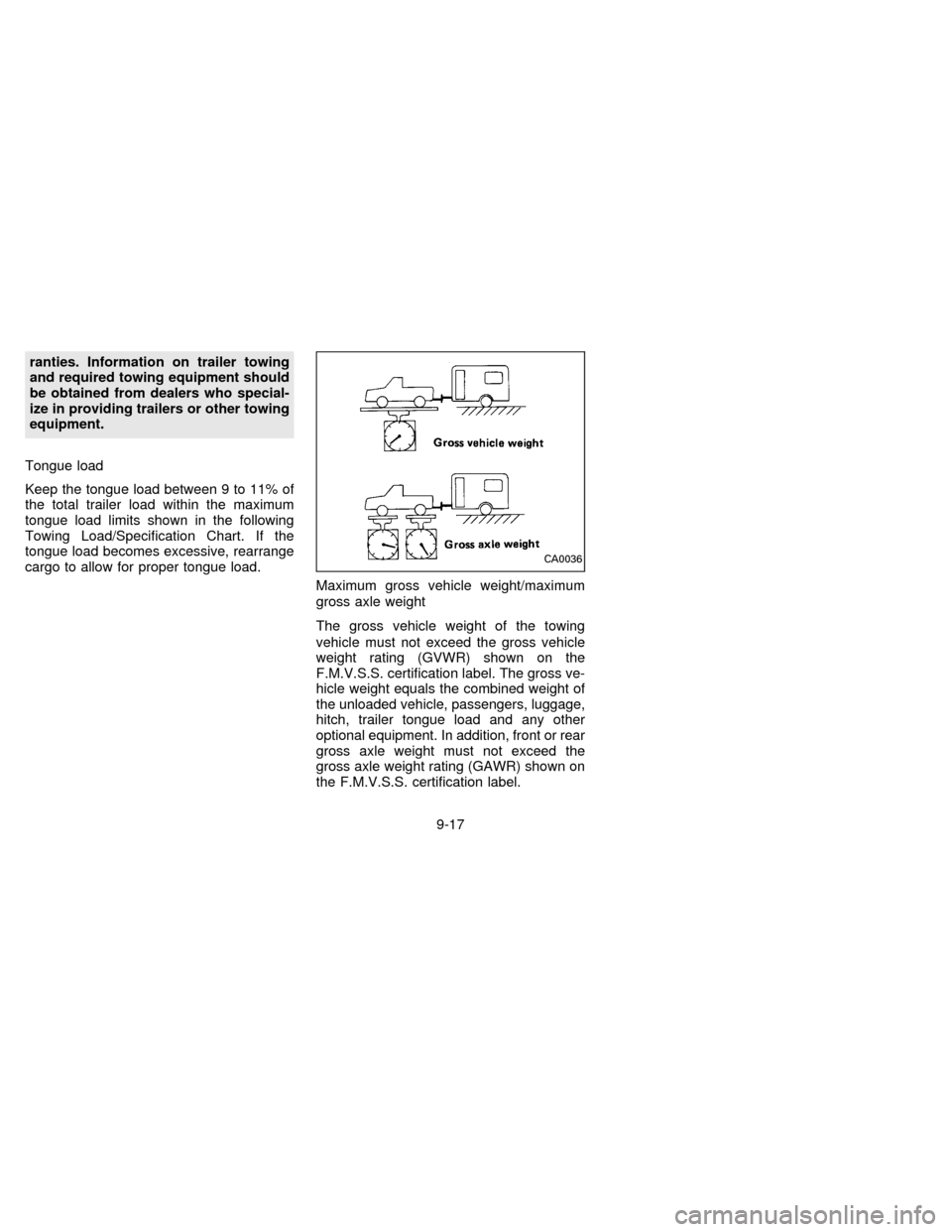
ranties. Information on trailer towing
and required towing equipment should
be obtained from dealers who special-
ize in providing trailers or other towing
equipment.
Tongue load
Keep the tongue load between 9 to 11% of
the total trailer load within the maximum
tongue load limits shown in the following
Towing Load/Specification Chart. If the
tongue load becomes excessive, rearrange
cargo to allow for proper tongue load.
Maximum gross vehicle weight/maximum
gross axle weight
The gross vehicle weight of the towing
vehicle must not exceed the gross vehicle
weight rating (GVWR) shown on the
F.M.V.S.S. certification label. The gross ve-
hicle weight equals the combined weight of
the unloaded vehicle, passengers, luggage,
hitch, trailer tongue load and any other
optional equipment. In addition, front or rear
gross axle weight must not exceed the
gross axle weight rating (GAWR) shown on
the F.M.V.S.S. certification label.
CA0036
9-17
ZX
Page 183 of 198
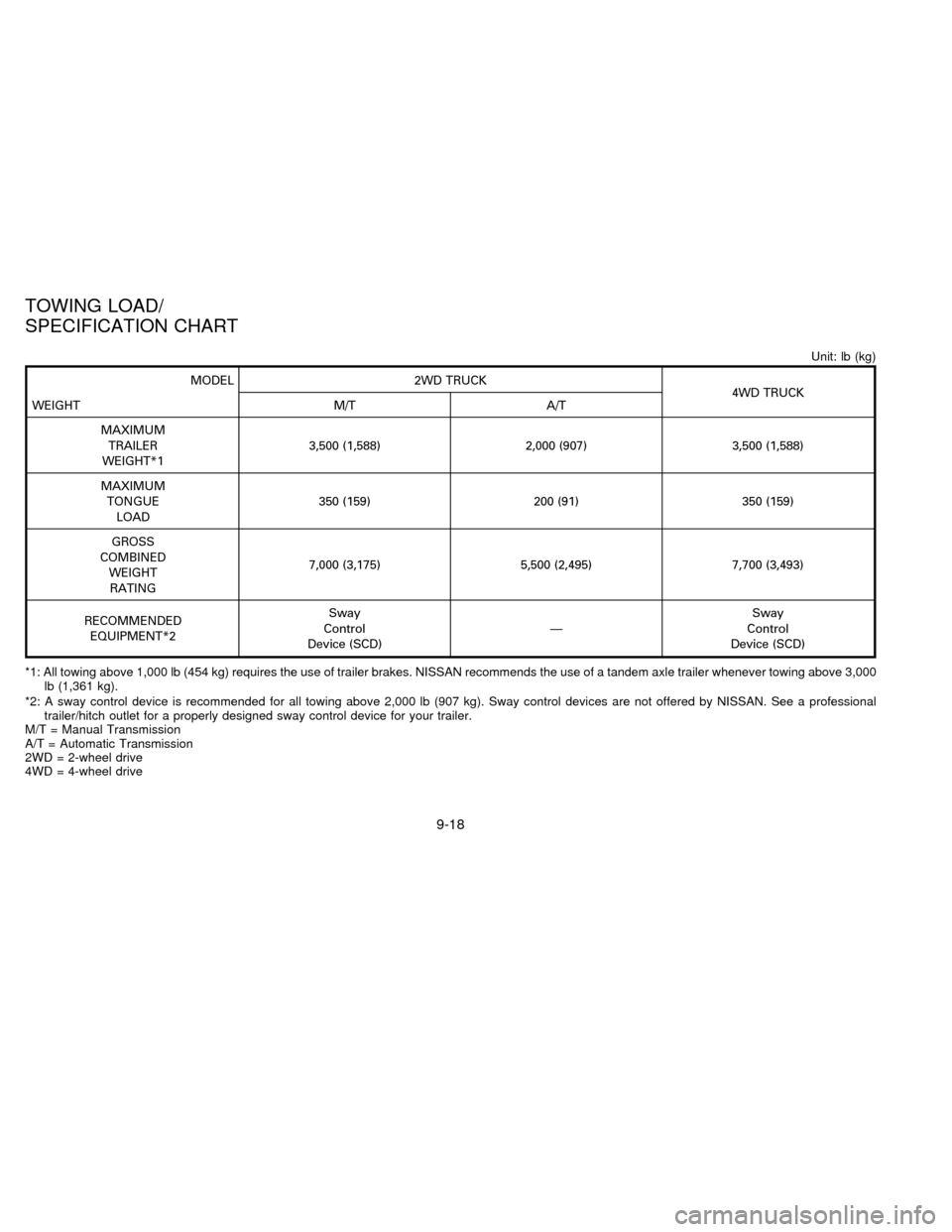
Unit: lb (kg)
MODEL
WEIGHT2WD TRUCK
4WD TRUCK
M/T A/T
MAXIMUM
TRAILER
WEIGHT*13,500 (1,588) 2,000 (907) 3,500 (1,588)
MAXIMUM
TONGUE
LOAD350 (159) 200 (91) 350 (159)
GROSS
COMBINED
WEIGHT
RATING7,000 (3,175) 5,500 (2,495) 7,700 (3,493)
RECOMMENDED
EQUIPMENT*2Sway
Control
Device (SCD)ÐSway
Control
Device (SCD)
*1: All towing above 1,000 lb (454 kg) requires the use of trailer brakes. NISSAN recommends the use of a tandem axle trailer whenever towing above 3,000
lb (1,361 kg).
*2: A sway control device is recommended for all towing above 2,000 lb (907 kg). Sway control devices are not offered by NISSAN. See a professional
trailer/hitch outlet for a properly designed sway control device for your trailer.
M/T = Manual Transmission
A/T = Automatic Transmission
2WD = 2-wheel drive
4WD = 4-wheel drive
TOWING LOAD/
SPECIFICATION CHART
9-18
ZX
Page 184 of 198
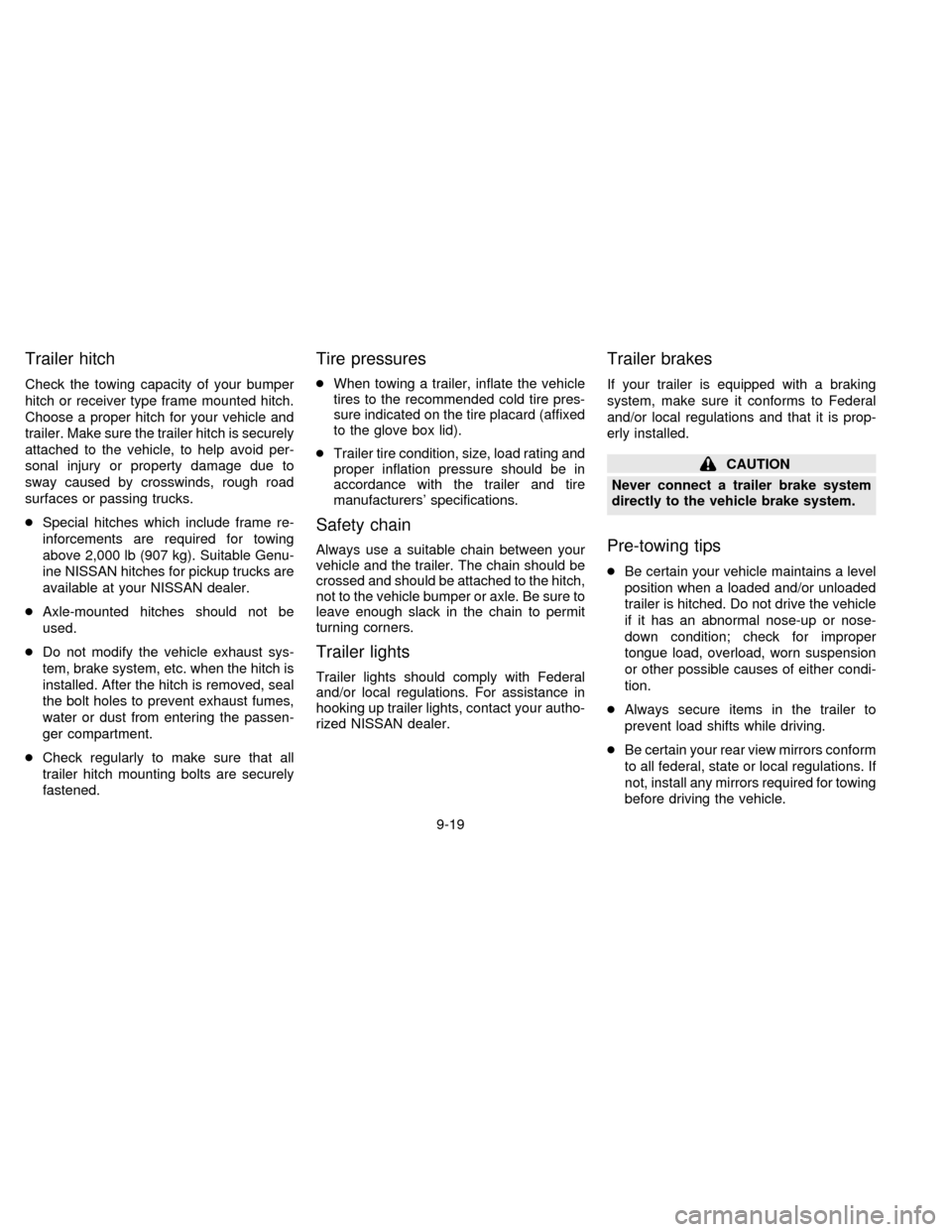
Trailer hitch
Check the towing capacity of your bumper
hitch or receiver type frame mounted hitch.
Choose a proper hitch for your vehicle and
trailer. Make sure the trailer hitch is securely
attached to the vehicle, to help avoid per-
sonal injury or property damage due to
sway caused by crosswinds, rough road
surfaces or passing trucks.
cSpecial hitches which include frame re-
inforcements are required for towing
above 2,000 lb (907 kg). Suitable Genu-
ine NISSAN hitches for pickup trucks are
available at your NISSAN dealer.
cAxle-mounted hitches should not be
used.
cDo not modify the vehicle exhaust sys-
tem, brake system, etc. when the hitch is
installed. After the hitch is removed, seal
the bolt holes to prevent exhaust fumes,
water or dust from entering the passen-
ger compartment.
cCheck regularly to make sure that all
trailer hitch mounting bolts are securely
fastened.
Tire pressures
cWhen towing a trailer, inflate the vehicle
tires to the recommended cold tire pres-
sure indicated on the tire placard (affixed
to the glove box lid).
cTrailer tire condition, size, load rating and
proper inflation pressure should be in
accordance with the trailer and tire
manufacturers' specifications.
Safety chain
Always use a suitable chain between your
vehicle and the trailer. The chain should be
crossed and should be attached to the hitch,
not to the vehicle bumper or axle. Be sure to
leave enough slack in the chain to permit
turning corners.
Trailer lights
Trailer lights should comply with Federal
and/or local regulations. For assistance in
hooking up trailer lights, contact your autho-
rized NISSAN dealer.
Trailer brakes
If your trailer is equipped with a braking
system, make sure it conforms to Federal
and/or local regulations and that it is prop-
erly installed.
CAUTION
Never connect a trailer brake system
directly to the vehicle brake system.
Pre-towing tips
cBe certain your vehicle maintains a level
position when a loaded and/or unloaded
trailer is hitched. Do not drive the vehicle
if it has an abnormal nose-up or nose-
down condition; check for improper
tongue load, overload, worn suspension
or other possible causes of either condi-
tion.
cAlways secure items in the trailer to
prevent load shifts while driving.
cBe certain your rear view mirrors conform
to all federal, state or local regulations. If
not, install any mirrors required for towing
before driving the vehicle.
9-19
ZX
Page 185 of 198

Trailer towing tips
In order to gain skill and an understanding
of the vehicle's behavior, you should prac-
tice turning, stopping and backing up in an
area which is free from traffic. Steering,
stability and braking performance will be
somewhat different than under normal driv-
ing conditions.
cAlways secure items in the trailer to
prevent load shift while driving.
c
Avoid abrupt starts, acceleration or stops.
cAvoid sharp turns or lane changes.
cAlways drive your vehicle at a moderate
speed.
cAlways block the wheels on both vehicle
and trailer when parking. Parking on a
slope is not recommended; however, if
you must do so, and if your vehicle is
equipped with automatic transmission,
first block the wheels and apply the park-
ing brake, and then move the transmis-
sion shift lever into the P position. If you
move the shift lever to the P position
before blocking the wheels and applying
the parking brake, transmission damage
could occur.cWhen going down a hill, shift into a lower
gear and use the engine braking effect.
When ascending a long grade, downshift
the transmission to a lower gear and
reduce speed to reduce chances of en-
gine overloading and/or overheating.
However, for long steep grades, do not
stay in 1st or 2nd gear when driving
above 35 MPH (56 km/h).
cIf the engine coolant rises to an ex-
tremely high temperature when the air
conditioning system is on, turn off the air
conditioner. Coolant heat can be addi-
tionally vented by opening the windows,
switching the fan control to high and
setting the temperature control to the
HOT position.
cTrailer towing requires more fuel than
normal circumstances.
cAvoid towing a trailer for your vehicle's
first 500 miles (800 km).
cHave your vehicle serviced more often
than at intervals specified in the recom-
mended Maintenance Schedule.
cWhen making a turn, your trailer wheels
will be closer to the inside of the turn than
your vehicle wheels. To compensate forthis, make a larger than normal turning
radius during the turn.
cCrosswinds and rough roads adversely
affect vehicle/trailer handling, possibly
causing vehicle sway. When being
passed by larger vehicles, be prepared
for possible changes in crosswinds that
could affect vehicle handling. If swaying
does occur, firmly grip the steering
wheel, steer straight ahead, and immedi-
ately (but gradually) reduce vehicle
speed. This combination helps to stabi-
lize the vehicle. Never increase speed.
cBe careful when passing other vehicles.
Passing while towing a trailer requires
considerably more distance than normal
passing. Remember the length of the
trailer must also pass the other vehicle
before you can safely change lanes.
cTo maintain engine braking efficiency
and electrical charging performance, do
not use fifth gear (manual transmission)
or overdrive (automatic transmission).
cAvoid holding the brake pedal down too
long or too frequently. This could cause
the brakes to overheat, resulting in re-
duced braking efficiency.
9-20
ZX
Page 186 of 198
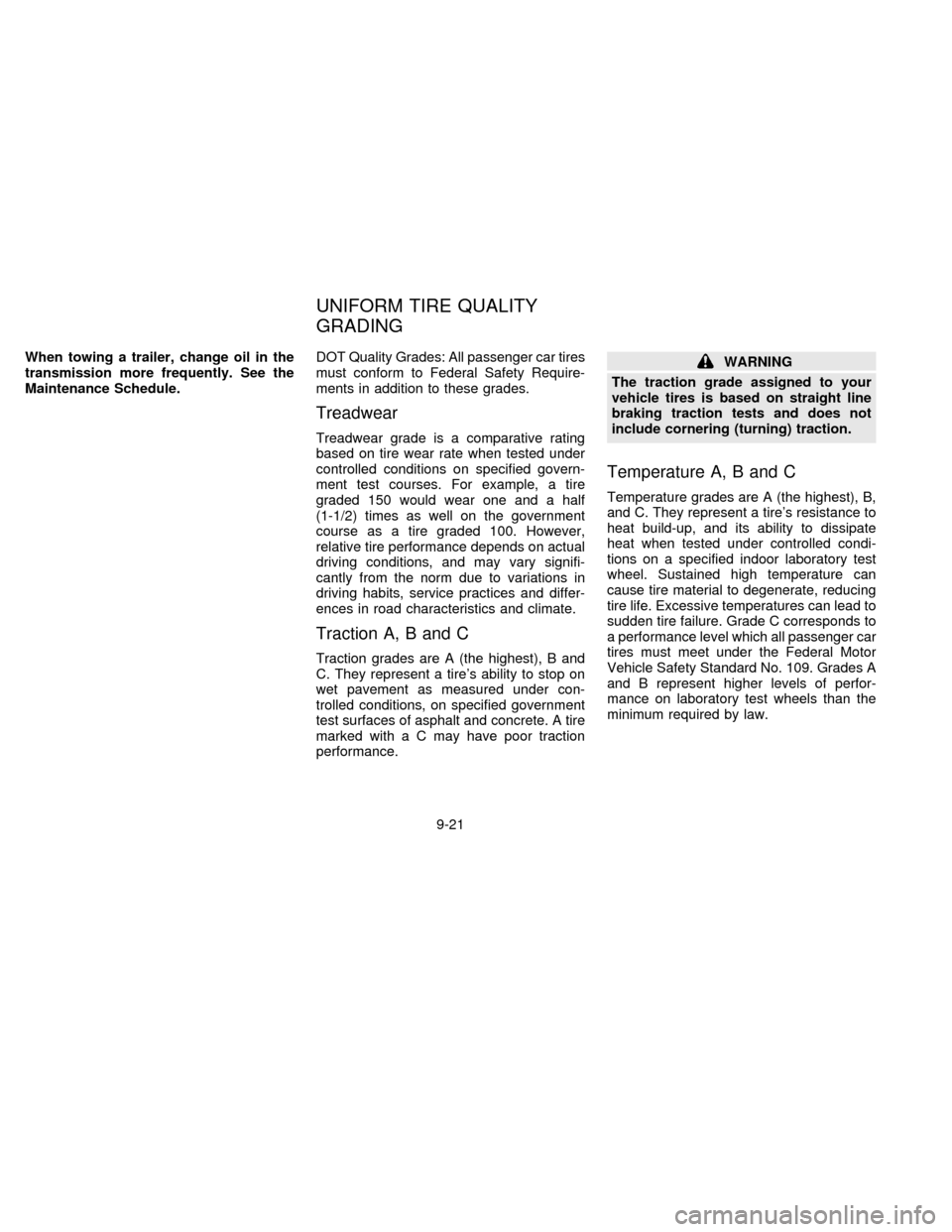
When towing a trailer, change oil in the
transmission more frequently. See the
Maintenance Schedule.DOT Quality Grades: All passenger car tires
must conform to Federal Safety Require-
ments in addition to these grades.
Treadwear
Treadwear grade is a comparative rating
based on tire wear rate when tested under
controlled conditions on specified govern-
ment test courses. For example, a tire
graded 150 would wear one and a half
(1-1/2) times as well on the government
course as a tire graded 100. However,
relative tire performance depends on actual
driving conditions, and may vary signifi-
cantly from the norm due to variations in
driving habits, service practices and differ-
ences in road characteristics and climate.
Traction A, B and C
Traction grades are A (the highest), B and
C. They represent a tire's ability to stop on
wet pavement as measured under con-
trolled conditions, on specified government
test surfaces of asphalt and concrete. A tire
marked with a C may have poor traction
performance.
WARNING
The traction grade assigned to your
vehicle tires is based on straight line
braking traction tests and does not
include cornering (turning) traction.
Temperature A, B and C
Temperature grades are A (the highest), B,
and C. They represent a tire's resistance to
heat build-up, and its ability to dissipate
heat when tested under controlled condi-
tions on a specified indoor laboratory test
wheel. Sustained high temperature can
cause tire material to degenerate, reducing
tire life. Excessive temperatures can lead to
sudden tire failure. Grade C corresponds to
a performance level which all passenger car
tires must meet under the Federal Motor
Vehicle Safety Standard No. 109. Grades A
and B represent higher levels of perfor-
mance on laboratory test wheels than the
minimum required by law.
UNIFORM TIRE QUALITY
GRADING
9-21
ZX
Page 196 of 198

Wheels and tires................................... 7-24
Towing
Tow truck towing .................................. 5-10
Towing load/specification chart ............ 9-18
Trailer towing ........................................ 9-16
2-wheel drive models ........................... 5-11
4-wheel drive models ........................... 5-12
Transfer case ............................................. 4-14
Transmission
Automatic transmission fluid ................... 7-9
Driving with automatic transmission ....... 4-6
Driving with manual transmission ........... 4-9
Travel (See registering your vehicle in
another country)
Trip odometer .............................................. 1-3
Truck-camper loading ................................ 9-23
Turn signal switch (See headlight and turn
signal switch)
V
Vanity mirror .............................................. 2-27
Vehicle dimensions and weights ............... 9-11
Vehicle identification
Vehicle identification number
(Chassis number) ................................. 9-12
Vehicle identification number plate ...... 9-12
Vehicle loading information ....................... 9-15
Vehicle recovery ........................................ 5-12
Ventilators .................................................... 3-2W
Warning
Supplemental air bag warning light ...... 2-15
Hazard warning flasher switch ............. 1-12
Warning/indicator lights and chimes ...... 1-6
Warning labels (for SRS)........................... 2-15
Weights (See dimensions and weights)
Wheel/tire size ........................................... 9-10
Wheels and tires ........................................ 7-24
Window washer fluid.................................. 7-12
Windows
Opera window....................................... 1-17
Power window ...................................... 1-15
Rear sliding window ............................. 1-16
Wiper
Windshield wiper and washer switch ... 1-11
Wiper blades......................................... 7-16
10-5
ZX
Page 197 of 198

Recommended fuel:
Unleaded gasoline, at least 87 AKI number
(RON 91)
For further details such as gasohol or diesel
fuel grade, see ``Fuel recommendation'' in
the ``Technical and consumer information''
section.
Recommended engine oil:
Energy Conserving Oils of API SG or SH,
SAE 5W-30 is preferable for all tempera-
tures. See ``Engine oil and oil filter recom-
mendation'' in the ``Technical and consumer
information'' section.
Tire cold pressure:
See the tire placard affixed to the glove box.
Recommended new vehicle
break-in procedure:
During the first 1,000 miles (1,600 km) of
vehicle use, follow the recommendations
outlined in the ``BREAK-IN SCHEDULE''
found in the ``Starting and Driving'' section
of this Owner's Manual. Follow these rec-
ommendations for the future reliability and
economy of your new vehicle. Failure tofollow these recommendations may result in
vehicle damage or shortened engine life.(page)
cIn case of emergency ...................... 5-1
(Flat tire, engine will not start, overheat-
ing, towing)
cHow to start the engine ................... 4-1
cHow to read the meters and
gauges ............................................. 1-1
cMaintenance schedule ..................... 8-1
cDo-it-yourself operations.................. 7-1
cTechnical and consumer
information ....................................... 9-1
GAS STATION INFORMATION QUICK REFERENCE
10-7
ZX